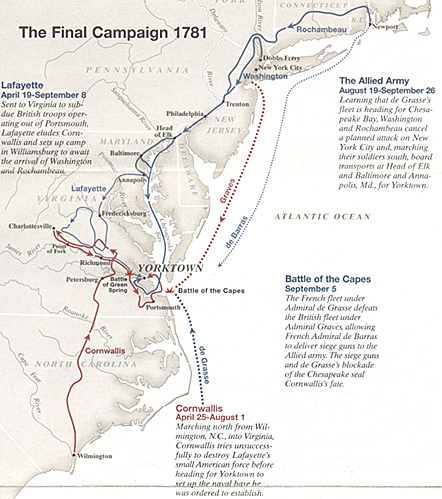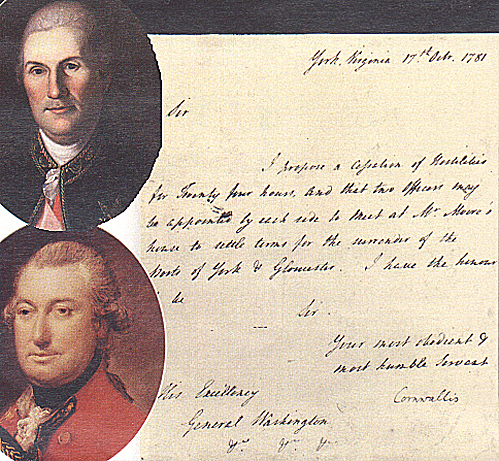 Historical Preliminaries
Historical Preliminaries
In May 1781, British commander Cornwallis advanced northward into Virginia with the idea that if Virginia could be suppressed, the rest of the colonies south would come back into the royal fold. In June, he received orders from Gen. Clinton, his superior in New York, to establish a naval base somewhere on the Chesapeake Bay. After a skirmish with American commander Lafayette and his force on July 6 near Jamestown, the so-called Battle of the Green Spring, Lafayette withdrew and Cornwallis continued his advance, finally selecting the port of Yorktown.
The port offered water deep enough for British warships, and at the time, was a commercial success. In early August Cornwallis had his 8,300-man force start to dig fortified lines around the port and general area, at first extending far outward, then later, closer to the town. The original outer works rested flanks on two streams and swamps, with good terrain only a few hundred yards wide in the middle. Cornwallis also sent a few hundred troops across the York River to create a fort at Gloucester Point to protect the army from the other side.
Meanwhile, a French Fleet under Admiral de Grasse sails from the West Indies and fights the Battle of the Capes on September 5, defeating British Admiral Graves and establishing a blockade of Cornwallis' force. This also allows French Admiral de Barras to deliver siege guns to the American and French forces around Yorktown.
Marching South
 George Washington and French General Rochambeau, whose combined forces were going to attack New York, learn that de Grasse is heading for Virginia. They too, march for the area, eventually boarding transport ships in Maryland and being taken to the Yorktown area, reachng it around September 28.
George Washington and French General Rochambeau, whose combined forces were going to attack New York, learn that de Grasse is heading for Virginia. They too, march for the area, eventually boarding transport ships in Maryland and being taken to the Yorktown area, reachng it around September 28.
Rochambeau (top) and Cornwallis (bottom). The note is from Cornwallis seeking surrender terms.
So, you have 17,000 American and French troops, siege guns, and a tight blockade versus 8,300 dug-in British troops. Their first siege line starts October 6, and on October 9, the siege guns begin hammering the British.
Cornwallis pulls back his troops to a tighter line except for two shoreline-area redoubts, number 9 and 10, which hold about 100 troops each.
On October 11, American/French troops start a second, closer siege line. However, it could not be completed because of the blocking power of the redoubts. On October 14, the Americans and French capture both redoubts, and three days later continue the second, closer siege line to hammer the British at point blank range.
Cornwallis tried to fight his way out of the siege, and later escape across the York River, but was turned back. The same terrain which strengthened the defense also prevented freedom of movement for the attempt. He also learned that he could not expect reinforcements or a relief force any time soon. On October 17, Cornwallis proposed a cease fire. On October 19, he formally surrendered the British forces.
More Yorktown Battlefield
- Introduction
Historical Preliminaries
Visitor's Center
The Quick Tour
Forward March...Ouch! Ouch!
Redoubts 9 and 10
Grand French Battery
Augustine Moore House
Surrender Field
Yorktown Victory Monument
Back to List of Battlefields
Back to Travel Master List
Back to MagWeb Master List of Magazines
© Copyright 2003 by Coalition Web, Inc.
This article appears in MagWeb (Magazine Web) on the Internet World Wide Web.
Other articles covering military history and related topics are available at http://www.magweb.com